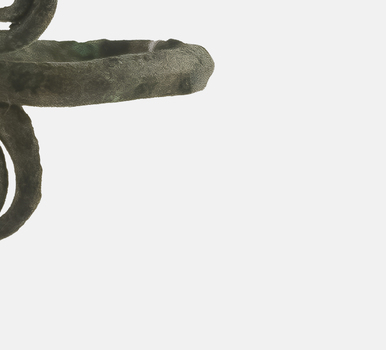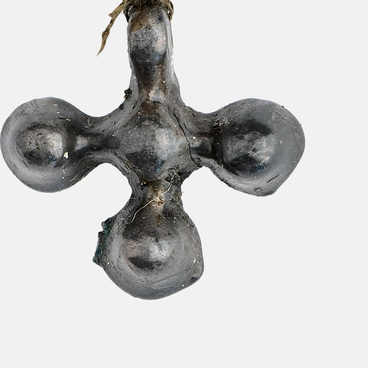In the summer of 1999, A.I. Nesterov, a resident of the village of Stepnoye (Chelyabinsk region), handed over a collection of items obtained from a sand pit to the staff of the archaeological expedition of Chelyabinsk State University and the Arkaim Museum-Reserve. The finds of local residents and the collection of archaeologists reflect one complex of burial structures, destroyed in the course of excavation works. The collection includes large fragments of ceramic vessels of the Bronze Age, bronze items — a torc and a dagger knife, as well as human bones. There was a granite slab above the burial. It was a paired adult burial, destroyed by the quarry. It was located in the south-eastern part of the pit two to three meters from the log cabin of the cattle burial ground.
The round bronze torc with open pointed ends is grooved in cross-section. Its diameter is 14.7 centimeters, the thickness of the sheet is 2 millimeters. The Chelyabinsk archaeologist Elena Kupriyanova distinguishes two types of torcs: 1) with a groove parallel to the horizontal surface; 2) with a groove perpendicular to the horizontal surface, similar to the groove of the bracelet. The torc presented in the exhibition belongs to the first type. Probably, the differences in the types of torcs are related to their different functional purposes. Traditionally, torcs were interpreted as neck jewelry. However, according to Elena Kupriyanova, the torcs belonging to the second type are associated with headdresses and could play the role of a crown. Another Chelyabinsk archaeologist Nikolai Vinogradov is of the opinion that torcs could not be used as neck ornaments at all, because they were bound to deform during bending and unbending. However, some of the torcs were definitely used in this way, as evidenced by the finds in the burials: the torcs are found on the necks of the buried. This is also evidenced by the quality of the jewelry.
The torc displayed in the museum is made of high-quality strong and resilient metal. During slight bending and unbending the ornament springs and keeps its shape, which is facilitated by the manufacturing technology: the torc is solid-cast and not bent by forging. Torcs are the largest one-piece jewelry, found quite rarely.


